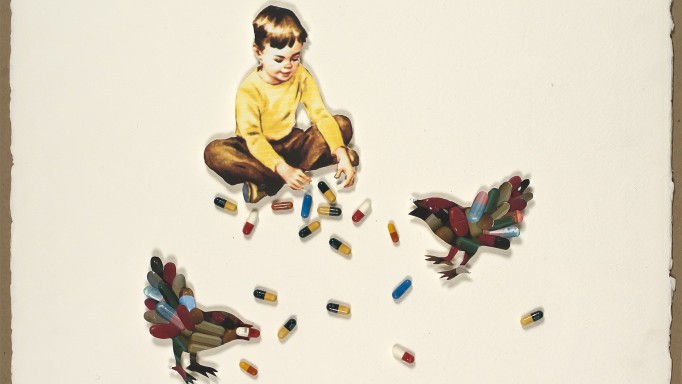Kaposi sarcoma (KS) is a type of cancer. It was one of the first life-threatening diseases seen in people with AIDS. It is an AIDS-defining condition, and remains one of the most common cancers in people living with HIV.
KS is caused by a virus called Kaposi sarcoma-associated herpesvirus (KSHV). In the family of herpes viruses, it is also known as HHV-8. Up to 5% of Americans are infected with KSHV, but it is more prevalent among people living with HIV. It is estimated that around 1 in 3 gay and bi men living with HIV and about 4% of HIV-positive women have KSHV.
Just having the virus is usually not enough to cause KS. The risk of the disease increases as a person’s immune system weakens, for example as they age, if they undergo an organ transplant or if they have HIV that is not suppressed by antiretroviral treatment.
KS can occurs when the virus infects cells that line blood and lymph vessels. This causes those cells to divide grow out of control and to live longer than they should. New vessels may also form and inflammation may increase. This can lead to the development of lesions or tumors on the skin, lining of the mouth or internal organ.
Several forms of KS are found worldwide, occurring more often in men than in women. A slower, somewhat benign form is found among men of Mediterranean and Jewish descent, while a more aggressive form is seen in younger men in Africa. People who have received transplant or transfusions are also at risk due to the immunosuppressive drugs they take.
Among people living with HIV, the risk for developing KS disease increases as the CD4 count falls, especially if it goes below 200. Therefore, being on effective HIV treatment often leads to remission of KS or prevents it from occurring in the first place. However, KS does sometimes occur in HIV-positive people with higher CD4 cell counts, even above 500.
What are the symptoms?
KS lesions or tumors can range in color from pinkish-red to brownish-blue or purplish and can look different in people with various skin tones. At first, the spots are usually flat, painless and do not turn white when pressure is applied to them (unlike bruises). Later, as the disease progresses, they can become painful and bleed.
KS can progress differently from person to person. In some, it develops very slowly with a new lesion appearing every few months or so. For others, lesions can appear more rapidly over a few weeks.
KS lesions on the skin are not usually life-threatening. However, they can be emotionally troubling, particularly when they occur in places where others can easily see them. Over time, lesions can develop elsewhere in the body, including the mouth, throat, lungs, gut or lymph nodes. This can lead to other symptoms such as pain when eating, difficulty swallowing food, difficulty breathing, or diarrhea, intestinal cramping and blood in the stool.
How is KS diagnosed?
Although KSHV can be detected in blood, testing positive doesn’t mean a person has KS disease. Therefore, a clinician will examine lesions visually and may do a biopsy to diagnose it.
For lesions on the skin or in the mouth, a small piece of tissue is removed and examined in a laboratory. For suspected KS in the throat, stomach, small intestine and lungs, a thin tube microscope is used to look for lesions, and a biopsy will be done if any are present. An X-ray may be done to examine the lungs. A stool sample may be taken to see if blood is present. A colonoscopy may also be done to find lesions in the colon and rectum, also with biopsy.
How is KS treated?
KS is not curable but it can be treated and controlled. The type of treatment is based on the location and severity of the lesions.
If a person has a detectable HIV viral load, starting antiretroviral treatment or switching medications is the first step in getting KS under control. No specific HIV medications are preferred over others for this purpose—the important thing is achieving full viral suppression.
While HIV treatment can stop or reverse KS progression, many people will not see existing KS lesions fully disappear. However, they may see a dramatic improvement in their size, shape and color, and new lesions may stop appearing.
Treatment decisions about lesions that are not life-threatening will depend on a person’s desire to be treated and willingness to deal with side effects. This applies especially to visible lesions on the face or other body parts that aren’t serious but can be stigmatizing.
Some people may choose to not treat KS right away and instead monitor for disease progression. Several drugs can be applied directly to skin lesions; these may shrink the lesions but will not prevent new ones from occurring. Chemotherapy and other systemic treatments are usually used for internal or more advanced KS. In some cases these medicines can cause serious side effects.
Local treatments:
- Minor surgery: When lesions are small and few in number, surgery may be done with a topical pain killer.
- Cryotherapy: Applying liquid nitrogen can freeze and kill KS cells. It is usually used to treat smaller lesions. Side effects may include swelling and blistering, and they may take several weeks to heal.
- Photodynamic therapy: This treatment involves injecting a light-sensitive substance lesions. A laser is then used to destroy cancer cells that have absorbed this substance.
- Low-dose radiation: Radiation therapy is usually used for larger and deeper skin lesions and on more sensitive skin areas like sex organs or feet.
- Gel: The vitamin A-related drug alitretinoin (Panretin) is applied to skin lesions three or four times a day. Side effects may include irritation and lightening of the skin.
- Cream: Imiquimod cream (Aldara and generics) is usually applied three times a week for 24 weeks. Side effects may include redness and itching.
- Injections: Vinblastine (Velban) or other drugs can be injected with a needle into lesion to reduce their size and improve their appearance. Side effects may include swelling, blistering and pain.
Systemic treatments:
- Chemotherapy: Chemotherapy medications used to treat KS include liposomal doxorubicin (Doxil and generics), paclitaxel (Taxol), vincristine (Oncovin and generics) and vinorelbine (Navelbine). Doxorubicin is usually preferred due to fewer side effects, but paclitaxel is often used if the disease relapses. Combination treatment may be used, but side effects often increase when using more than one drug.
- Targeted therapy: These medications, including targeted drugs known as kinase inhibitors may be used to stop blood vessel formation and block blood flow to lesions.
- Immune-modulating drugs: Pomalidomide (Pomalyst) helps the immune system fight cancer, as well as blocking blood vessel formation. It was approved for KS in May 2020, making it the first new treatment in over 20 years. A similar drug, lenalidomide (Revlimid), is being studied in clinical trials.
Are there any experimental treatments?
Over the past few years, researchers have learned a lot about KS, including how lesions form. Several promising new drugs are in clinical studies.
A type of immunotherapy using monoclonal antibodies known as checkpoint inhibitors has shown promise in controlling KS. One recent study found that among nine HIV-positive men who were treated with nivolumab (Opdivo) or pembrolizumab (Keytruda) for other types of cancer, five experienced partial KS remission, one had full remission and three had ongoing stable disease. Both drugs were well tolerated.
To learn more about studies of new therapies for treating or preventing KS, visit ClinicalTrials.gov. The site has information about all HIV-related clinical studies in the United States. Or, call toll-free at 1-800-HIV-0440 (1-800-448-0440) or email contactus@aidsinfo.nih.gov.
Last Reviewed: May 19, 2020














